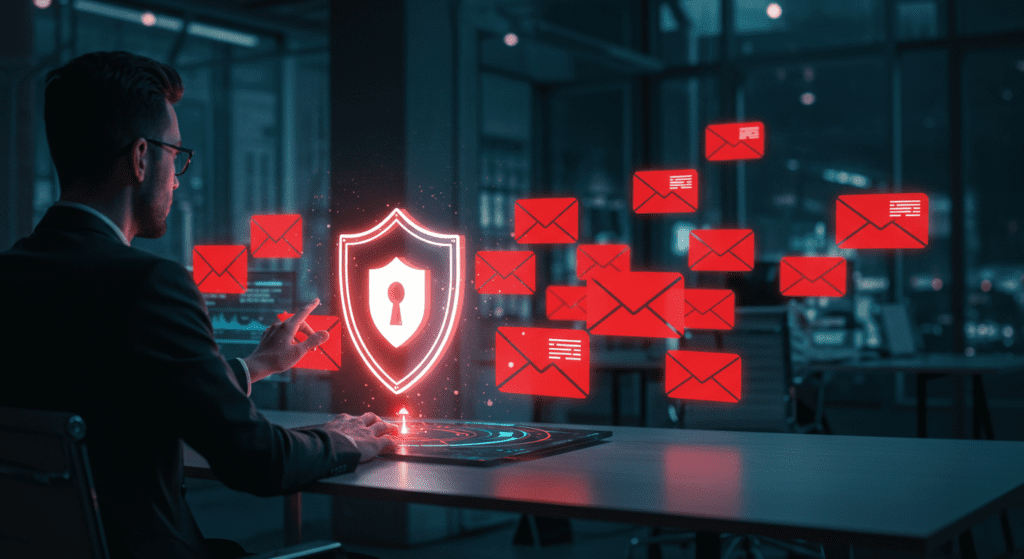Imagine opening an email that looks like it’s from your CEO, urgently requesting payment details. You pause—something feels off. Good instinct! In 2025, these How to protect businesses from AI-Powered phishing attacks are smarter and sneakier than ever, driven by artificial intelligence.
Cybercriminals use AI to craft phishing emails that slip past filters and trick even cautious employees. Protecting your business from these AI-driven scams is critical, and this blog has you covered. We’ll explore AI-powered phishing scam prevention techniques, reveal tips for Detecting AI-generated phishing emails and outline Cybersecurity strategies against AI phishing threats.
Whether you’re a small business owner, an IT pro, or just curious about staying safe online, you’ll discover the best tools to prevent AI-driven phishing attacks and practical steps to fight back. Let’s dive in and outsmart those scammers!
How to Protect Businesses from AI-Powered Phishing Attacks
Protecting your business from AI-enhanced cyber threats starts with knowing what you’re up against. These aren’t the clumsy phishing emails of the past—AI makes them personal and tough to spot. I once saw a friend nearly fall for an email “from” her manager, complete with details only an insider would know. Spoiler: her manager was out of town
Here’s how to fight back
- Strong Passwords & MFA: Use complex passwords (16+ characters) and enforce multi-factor authentication (MFA) everywhere. It’s a simple lock that keeps hackers out.
- Regular Updates: Keep software patched—those updates fix vulnerabilities
- Team Training: Your secret weapon is phishing awareness training for employees. Run fake phishing tests; a client of mine slashed clicks by 40% after one session.
In 2025, staying ahead means being proactive. AI-powered phishing evolves fast, but these basics build a solid foundation for business IT safety.
AI-Powered Phishing Scams Prevention Techniques
AI-driven scams are sophisticated—they craft flawless emails, mimic styles, and even fake voices with deep fake scams in business. So, what are the AI-powered phishing scam prevention techniques? Start with sharp instincts. Always check the sender’s email—hover over it to catch fakes like “hr@yourcompany.co” instead of “.com.” I dodged a scam once when a “bank” email had a shady domain.
Layer on tech:
- Email Filters: Use AI-powered cyber threat detection tools to spot odd patterns—like an email from a “daytime” colleague at midnight.
- Data Discipline: Limit what you share online—social engineering AI tactics thrive on LinkedIn details. A coworker got hit after posting about a promotion; the scammer used it to sound legit.
Combine human vigilance with email security against AI scams, and you’ve got a fighting chance against these machine-learning-based phishing tricks.
Detecting AI-Generated Phishing Emails
Spotting Detecting AI-generated phishing emails in 2025 is like playing detective—AI makes them look real, but clues give them away. Watch for urgency: phrases like “act now” or “account locked” scream scam. I got a fake Netflix cancellation notice last month—the panic vibe was a red flag.
Key tips:
- Check Links: Hover over URLs (don’t click!) to spot fakes—identifying phishing links in AI-generated emails is crucial. Legit firms don’t use “login-xyz.com.”
- Spot Oddities: AI might miss subtle cues—like a generic “Dear Customer” from your “personal” bank.
Cybersecurity Strategies Against AI Phishing Threats
To tackle Cybersecurity strategies against AI phishing threats, you need a plan that matches AI’s cunning. These attacks—like spear phishing vs. AI phishing—target specific people with tailored lures, so your defenses must be sharp. Adopt a Zero Trust approach—verify every email, even from “trusted” sources. If “HR” asks for payroll info, call them to confirm.
More strategies:
- Advanced Security: AI-based email security solutions for phishing protection use machine learning to catch anomalies—like a CFO emailing from a new IP. A small firm I know dodged a $50,000 hit this way.
- Network Protection: Encrypt data, segment networks (limit breach spread), and audit access. A quarterly audit once caught a rogue account at a buddy’s company—pure luck.
- Stay Current: Follow cybersecurity best practices for businesses in 2025—AI evolves, so should you.
These steps shield against cybercriminals using AI for advanced scams, keeping your corporate security tight.

Best Tools to Prevent AI-Driven Phishing Attacks
The Best tools to prevent AI-driven phishing attacks are your heavy hitters against AI’s tricks. Here’s the lineup:
- Barracuda Sentinel Blocks real-time AI-powered cyber threats and protects domains. I saw it nab a fake invoice scam mid-send. It starts at $2 per user/month.
- Proofpoint TAP: Excels at preventing business email compromise (BEC) attacks, scanning links and files. A friend’s startup credits it for stopping a payroll scam. Pricing varies by size.
- CrowdStrike Falcon: Beyond malware, it tackles automated scam detection across devices. Great for broader enterprise data protection.
- Mimecast: Combines phishing attack detection with machine learning and training tools. Perfect for small teams.
Free options like Google’s Safe Browsing help, too—quick link checks on the fly. Costs range, but the investment beats a breach. These tools turn AI-driven scams into a losing game for hackers.
Real-World Insights & Extra Layers
Let’s add depth with examples. For AI phishing attack examples and prevention, consider a 2024 case—a U.S. bank lost $100,000 to a deepfake voice scam faking an exec. Prevention? Record key voices and verify big asks in person. Then there’s how AI chatbots create phishing emails—scrape data to mimic colleagues. I got a fake Slack ping once, citing my project deadline—creepy stuff. Lock down social media to starve them out.
How businesses can stop AI-generated phishing emails shines in action. A retailer I know cut incidents by 60% with AI-based email security solutions for phishing protection and staff quizzes. How AI is used for phishing scams and fraud scales fast, but machine learning and phishing detection in cybersecurity catch patterns—like repeated email templates. In 2025, pairing tech with human savvy is your edge.

Conclusion
AI-powered phishing is a crafty foe, but you’re not defenseless. From How to protect businesses from AI phishing attacks to wielding the Best tools to prevent AI-driven attacks, you’ve got the tools to win. Cybercriminals use AI-enhanced cyber threats to strike, but you can strike back with Cybersecurity strategies against AI phishing threats.
Train your team, deploy smart defenses, and stay vigilant—that’s how you beat machine-learning-based phishing in 2025. Ready to safeguard your business from AI-powered phishing? Start by implementing AI-based email security tools and training your team today! Don’t wait for a scam to hit—act now and keep your business secure.
FAQs
How Can You Master Detecting AI-Generated Phishing Emails in 2025?
Watch for urgency (“act now!”) or odd URLs. Phishing attack detection with machine learning spots quirks—like a “client” emailing at odd hours. I caught a fake by checking the domain—close, but not quite.
What Are Top AI-Powered Phishing Scams Prevention Techniques?
Train staff on social engineering AI tactics, use AI-driven fraud detection filters and verify big requests separately. A friend’s firm dodged a scam by calling their “boss”—he hadn’t sent a thing.
What Are the Best Tools to Prevent AI-Driven Phishing Attacks?
Barracuda, Proofpoint, and CrowdStrike lead with automated scam detection. Mimecast adds training perks. A startup pal swears by Proofpoint—it’s a digital gatekeeper.
Why Are Cybersecurity Strategies Against AI Phishing Threats Essential?
AI makes phishing personal—spear phishing vs. AI phishing zeroes in on you. Without business IT safety, one slip could cost a fortune. Zero Trust keeps threats out cold.

